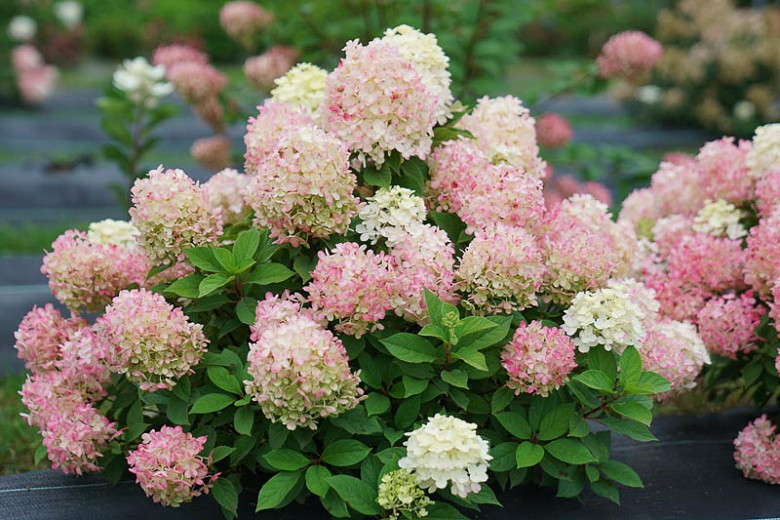The Tiny Hydrangea That Packs A Big Punch
The Tiny Hydrangea That Packs a Big Punch
Hydrangeas are some of the most popular flowering shrubs in the world, and for good reason. They come in a wide variety of colors, sizes, and shapes, and they can add a touch of elegance to any garden. But what if you don't have a lot of space? Or what if you're looking for a hydrangea that's a little bit different?
If so, then you might want to consider the Little Lime Punch hydrangea. This diminutive shrub is only about 3 feet tall and wide, but it packs a big punch in terms of blooms. The flowers start out as a lime green color, and then they gradually change to pink, white, and red as the season progresses. This makes for a truly stunning display that will brighten up your garden all summer long.
In addition to its small size, Little Lime Punch hydrangea is also very easy to care for. It prefers full sun, but it can tolerate some shade. It is also drought tolerant, so you won't have to water it too often.
If you're looking for a beautiful and low-maintenance hydrangea, then Little Lime Punch is a great option. It's the perfect choice for small gardens, containers, or even rock gardens.
Here are some additional details about Little Lime Punch hydrangea:
- Bloom time: Early summer to late summer
- Flower color: Lime green, pink, white, red
- Sun exposure: Full sun to partial shade
- Soil: Moist, well-drained soil
- Drought tolerance: Moderate
- Pests and diseases: Few
How to care for Little Lime Punch hydrangea:
- Plant in full sun to partial shade.
- Water regularly, especially during the first year after planting.
- Apply a balanced fertilizer once a month during the growing season.
- Deadhead spent flowers to encourage new blooms.
- Protect from frost in colder climates.
Little Lime Punch hydrangea is a great addition to any garden. It's small, easy to care for, and it produces stunning blooms all summer long. If you're looking for a unique and beautiful hydrangea, then Little Lime Punch is a great choice.
If you're looking for a small, yet stunning hydrangea to add to your garden, the Fire Light Tidbit is a great option. This variety is the smallest panicle hydrangea on the market, reaching just 2-3 feet tall and wide. But don't let its size fool you - Fire Light Tidbit is packed with blooms! The flowers start out white and gradually turn pink and red as the summer progresses. They're also long-lasting, so you'll enjoy their beauty for months on end.
In addition to its beautiful flowers, Fire Light Tidbit is also a very easy-care plant. It's hardy in zones 3-8, so it can be grown in most parts of the country. It prefers full sun or partial shade, and it's not too fussy about soil type. Just make sure to water it regularly, especially during the hot summer months.
If you're interested in learning more about Fire Light Tidbit, I encourage you to visit . This website has a wealth of information about the plant, including its care requirements, planting instructions, and more.
FAQ of hydrangea firelight tidbit
Q: What is hydrangea firelight tidbit?
A: Hydrangea firelight tidbit is a variety of hydrangea that is known for its beautiful, fire-engine red flowers. It is a deciduous shrub that grows to be about 4-6 feet tall and wide. Hydrangea firelight tidbit is a relatively easy plant to care for, and it is tolerant of a wide range of soil conditions.
Q: What are the best growing conditions for hydrangea firelight tidbit?
A: Hydrangea firelight tidbit prefers full sun to partial shade, and it does best in moist, well-drained soil. The soil pH should be slightly acidic, between 5.5 and 6.5.
Q: How do I care for hydrangea firelight tidbit?
A: Hydrangea firelight tidbit is a relatively low-maintenance plant. It should be watered regularly, especially during the hot summer months. Fertilize the plant in spring with a balanced fertilizer. Deadhead spent flowers to encourage new blooms.
Q: How do I propagate hydrangea firelight tidbit?
A: Hydrangea firelight tidbit can be propagated by taking cuttings in early spring. Choose a healthy, non-flowering stem and cut it at a 45-degree angle. Remove the bottom leaves and dip the cutting in rooting hormone. Plant the cutting in a pot of moist potting mix and keep it in a warm, humid environment. The cutting should root in about 6-8 weeks.
Q: What are some common pests and diseases of hydrangea firelight tidbit?
A: Hydrangea firelight tidbit is susceptible to a few pests and diseases, including aphids, scale, and powdery mildew. Aphids can be controlled with insecticidal soap or neem oil. Scale can be controlled with horticultural oil. Powdery mildew can be controlled by improving air circulation and watering the plant in the morning so the leaves have time to dry before nightfall.
Image of hydrangea firelight tidbit
- Image 1: A close-up of a hydrangea firelight tidbit flower. The flower is white with a hint of pink, and it has a delicate, cascading shape.

- Image 2: A full-size hydrangea firelight tidbit bush in bloom. The bush is covered in white flowers, and it has a lush, green foliage.

- Image 3: A hydrangea firelight tidbit flower arrangement in a vase. The flowers are arranged in a cascading pattern, and they create a beautiful focal point in the room.

- Image 4: A hydrangea firelight tidbit plant in a garden. The plant is surrounded by other flowers and plants, and it adds a touch of elegance to the garden.

- Image 5: A hydrangea firelight tidbit seed pod. The seed pod is brown and spiky, and it is a reminder of the beauty of the flower that came before it.

Post a Comment for "The Tiny Hydrangea That Packs A Big Punch"